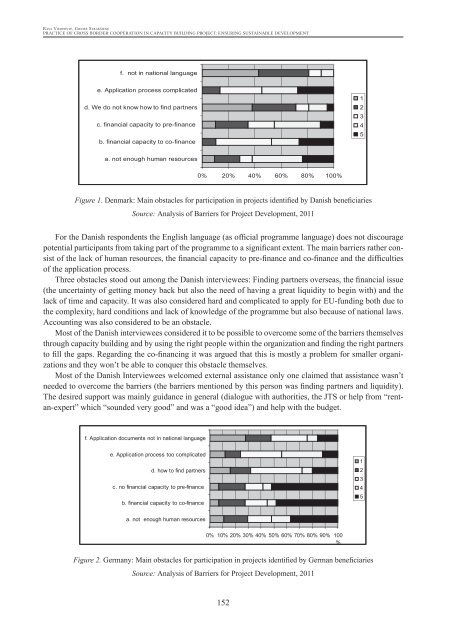Regional Formation 2012,1 - KlaipÄdos universitetas
Regional Formation 2012,1 - KlaipÄdos universitetas
Regional Formation 2012,1 - KlaipÄdos universitetas
You also want an ePaper? Increase the reach of your titles
YUMPU automatically turns print PDFs into web optimized ePapers that Google loves.
Rasa Viederytė, Giedrė Strakšienė<br />
PRACTICE OF CROSS BORDER COOPERATION IN CAPACITY BUILDING PROJECT: ENSURING SUSTAINABLE DEVELOPMENT<br />
f. not in national language<br />
e. Application process complicated<br />
d. We do not know how to find partners<br />
c. financial capacity to pre-finance<br />
b. financial capacity to co-finance<br />
1<br />
2<br />
3<br />
4<br />
5<br />
a. not enough human resources<br />
0% 20% 40% 60% 80% 100%<br />
Figure 1. Denmark: Main obstacles for participation in projects identified by Danish beneficiaries<br />
Source: Analysis of Barriers for Project Development, 2011<br />
For the Danish respondents the English language (as official programme language) does not discourage<br />
potential participants from taking part of the programme to a significant extent. The main barriers rather consist<br />
of the lack of human resources, the financial capacity to pre-finance and co-finance and the difficulties<br />
of the application process.<br />
Three obstacles stood out among the Danish interviewees: Finding partners overseas, the financial issue<br />
(the uncertainty of getting money back but also the need of having a great liquidity to begin with) and the<br />
lack of time and capacity. It was also considered hard and complicated to apply for EU-funding both due to<br />
the complexity, hard conditions and lack of knowledge of the programme but also because of national laws.<br />
Accounting was also considered to be an obstacle.<br />
Most of the Danish interviewees considered it to be possible to overcome some of the barriers themselves<br />
through capacity building and by using the right people within the organization and finding the right partners<br />
to fill the gaps. Regarding the co-financing it was argued that this is mostly a problem for smaller organizations<br />
and they won’t be able to conquer this obstacle themselves.<br />
Most of the Danish Interviewees welcomed external assistance only one claimed that assistance wasn’t<br />
needed to overcome the barriers (the barriers mentioned by this person was finding partners and liquidity).<br />
The desired support was mainly guidance in general (dialogue with authorities, the JTS or help from “rentan-expert”<br />
which “sounded very good” and was a “good idea”) and help with the budget.<br />
f. Application documents not in national language<br />
e. Application process too complicated<br />
d. how to find partners<br />
c. no financial capacity to pre-finance<br />
b. financial capacity to co-finance<br />
1<br />
2<br />
3<br />
4<br />
5<br />
a. not enough human resources<br />
0% 10% 20% 30% 40% 50% 60% 70% 80% 90% 100<br />
%<br />
Figure 2. Germany: Main obstacles for participation in projects identified by German beneficiaries<br />
Source: Analysis of Barriers for Project Development, 2011<br />
152
















